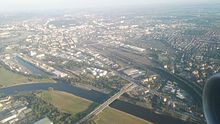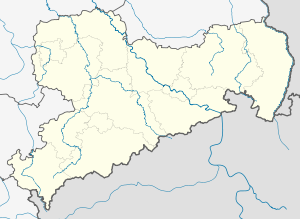Wing way bridge
Coordinates: 51 ° 3 ′ 51 ″ N , 13 ° 41 ′ 23 ″ E
| S 73 wing bridge | ||
|---|---|---|
| Convicted | State Road 73 | |
| Subjugated | Elbe , km 61.24 | |
| place | Dresden | |
| construction | Composite steel bridge | |
| overall length | 285 m | |
| width | 2 × 15.5 m | |
| Longest span | 115 m | |
| Construction height | 4.0 m to 5.5 m | |
| Clear height | 6.53 m above HSW | |
| location | ||
|
|
||
The Flügelwegbrücke is the seventh bridge in Dresden over the Elbe . The 285 m long girder bridge was built for the first time between 1929 and 1930 and, as part of the outer city ring, connects the northern districts of Trachau , Pieschen and Mickten on the right bank of the Elbe with the opposite districts of Löbtau and Cotta .
history
Bridge name
The bridge was inaugurated on October 1, 1930 under the name Kaditzer Bridge . Most, however, was from the Flügelwegbrücke spoken since the extension of the wing path leads to the bridge. In 1984, the bridge was named after the former KPD -Funktionär in Rudolf Renner bridge renamed before 1994 as official name Flügelwegbrücke was introduced.
Old bridge construction
The first construction was a four-span steel girder bridge with a span of 65 m + 115 m + 65 m + 40 m. This had three 5.5 m high riveted solid wall girders in the longitudinal direction , which were vouted over the river pillars to a height of 7.4 m . The total cost was given as 2.3 million marks. The bridge construction was designed in such a way that a main girder could be added on each side in order to be able to transfer an underground railway in the bridge cross-section. The abutments had already been made for this. Due to insufficient load-bearing capacity and as a bottleneck in the outer city ring west, the bridge had to be replaced at the beginning of the 21st century.
New building

The new bridge was built as a steel composite structure with two separate superstructures for three lanes each as well as a sidewalk and a cycle path between 2001 and 2004. The total construction costs (including road construction) were around 17 million euros.
Foundation and substructures
The old foundations of the three pillars were reinforced with injection piles and built on these new pillars. The existing abutments were rebuilt and reinforced.
Superstructures
The superstructures of the steel composite bridge have a 5.25 m wide steel trough at the bottom and a 15.5 m wide reinforced concrete deck slab tapered in the transverse direction, connected with headed dowels . About the two current pillars, the steel girders have m is a maximum cross-sectional height of 5.5 m and are in the longitudinal direction with a height in the midspan of 4.0 haunched formed. The spans of the four-span superstructures are unchanged at 65 m + 115 m + 65 m + 40 m.
Construction work
During the construction period, three lanes as well as a cycle and walkway always had to be usable. This led to the following construction process. First of all, the eastern superstructure next to the old bridge was built on temporary substructures and then the traffic was directed over it. Then the old superstructure, as well as the pillars and parts of the abutments, were demolished. In the third step, the new substructures and the western superstructure were built. After the traffic had been relocated to the western superstructure, the eastern superstructure could finally be brought into its final position by lateral displacement and the temporary substructures demolished.
The superstructure was assembled in the foreland area on auxiliary scaffolding with one or two truck- mounted cranes , the 86 m long middle section weighing 376 tons was welded together from three sections in the port, delivered by ship and lifted in with strand jacks. Finally, the reinforced concrete deck slab was produced in sections using a formwork carriage , with the deck slab being produced first in the middle of the field and then the gaps above the support areas.
Traffic load
- 2009: 42,500 vehicles / 24h
- 2015: 44,400 vehicles / 24h
- 2016: 45,900 vehicles / 24h
Trivia
On the morning of January 28, 2012, a Czech cargo ship struck a pillar foundation of the bridge while leaving the nearby Alberthafen and ran aground. The ship was already salvaged on January 29, 2012 with several tug boats, power thrusters and other heavy equipment.
Individual evidence
- ^ Dresden Waterways and Shipping Office
- ↑ 2009 census, 2020 forecast and 2025 forecast ( Memento from May 4, 2014 in the Internet Archive ) (PDF; 12 kB)
- ↑ Flügelwegbrücke is in front , Dresden Latest News from February 25/26, 2017
- ↑ Flügelwegbrücke is in front , Dresden Latest News from February 25/26, 2017
- ↑ a b Iris Hellmann: Czech freighter rams wing way bridge. In: SZ-Online.de. Sächsische Zeitung GmbH, January 30, 2012, accessed on January 30, 2012 .
literature
- Erich Fiedler: Bridges of City Expansion. Albertbrücke - Carolabrücke - Flügelwegbrücke. In: Dresdner Geschichtsverein eV (ed.): Dresdner Elbbrücken in eight centuries , Dresdner Hefte No. 94, Dresden 2008, pp. 51–60
- Erich Fiedler: Road bridges over the Elbe . Saxoprint, Dresden 2005, ISBN 3-9808879-6-0 , pp. 36-46
Web links
| upstream | Bridges over the Elbe | downstream |
| Marienbrücke (Dresden) | Wing way bridge |
Elbe Bridge Dresden (A 4) |


